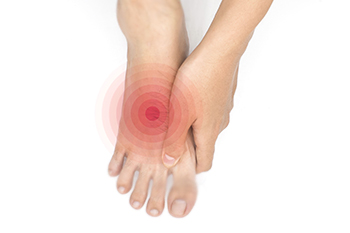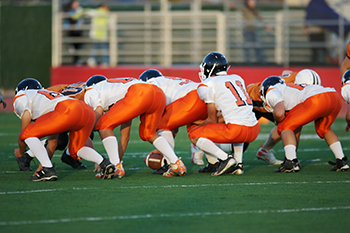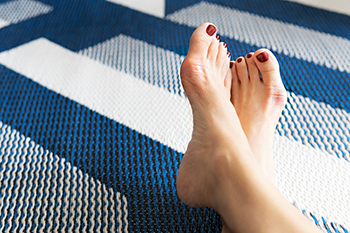Kirksville (660) 665-9000
April 2023
Using a Mirror for Diabetic Foot Care

People who are diabetic often are aware of the extra attention the feet need. A good diabetic foot care routine begins by washing and drying the feet. This is followed by closely inspecting the soles of the feet by using a mirror, which is helpful in noticing if existing cuts, bruises, or scrapes have developed. It is imperative to wear shoes that fit correctly, in addition to refraining from walking barefoot outside. Many diabetic patients have their toenails professionally trimmed weekly, which may help to prevent painful ingrown toenails from occurring. Neuropathy is a common condition diabetic people may get. This is defined as the inability to feel existing cuts on their feet, and untreated wounds may lead to getting a diabetic foot ulcer. If you have diabetes, it is strongly suggested that you are under the care of a podiatrist who can help you to manage this serious condition.
Diabetic foot care is important in preventing foot ailments such as ulcers. If you are suffering from diabetes or have any other concerns about your feet, contact Deborah Holte, DPM from Northeast Missouri Foot Clinic. Our doctor can provide the care you need to keep you pain-free and on your feet.
Diabetic Foot Care
Diabetes affects millions of people every year. The condition can damage blood vessels in many parts of the body, especially the feet. Because of this, taking care of your feet is essential if you have diabetes, and having a podiatrist help monitor your foot health is highly recommended.
The Importance of Caring for Your Feet
- Routinely inspect your feet for bruises or sores.
- Wear socks that fit your feet comfortably.
- Wear comfortable shoes that provide adequate support.
Patients with diabetes should have their doctor monitor their blood levels, as blood sugar levels play such a huge role in diabetic care. Monitoring these levels on a regular basis is highly advised.
It is always best to inform your healthcare professional of any concerns you may have regarding your feet, especially for diabetic patients. Early treatment and routine foot examinations are keys to maintaining proper health, especially because severe complications can arise if proper treatment is not applied.
If you have any questions please feel free to contact our office located in Kirksville, MO . We offer the newest diagnostic and treatment technologies for all your foot and ankle needs.
Treatment Options for Turf Toe Injury

Turf toe is an injury that affects the base of the big toe, which is termed the first metatarsophalangeal, or MTP joint. It occurs from repeatedly overstretching that joint. This is a common injury among football or soccer players, and dancers who frequently overextend the MTP joint with the heels raised. Turf toe is considered to be a toe sprain, and ignoring it can be detrimental to continuing your sport. Resting the toe is essential, but more serious treatment options may be required in order for the MTP joint to fully heal and activity to resume. A visit to a podiatrist may involve ultrasound or electric stimulation techniques, as well as prescribing non-steroidal anti-inflammatory medication to reduce pain. In many cases, being fitted for an orthotic shoe insert may be deemed necessary. In extreme cases, surgery is recommended to repair any tears, fractures, or other joint damage. For a proper diagnosis of your turf toe sprain, along with an appropriate treatment plan, it is suggested that you make an appointment with a podiatrist.
Toe pain can disrupt your daily activities. If you have any concerns, contact Deborah Holte, DPM of Northeast Missouri Foot Clinic. Our doctor can provide the care you need to keep you pain-free and on your feet.
What Causes Toe Pain?
Most severe toe pain is caused due to a sports injury, trauma from dropping something heavy on the toe, or bumping into something rigid. Other problems can develop over time for various reasons.
Toe pain can be caused by one or more ailments. The most common include:
- Trauma
- Sports injury
- Wearing shoes that are too tight
- Arthritis
- Gout
- Corns and calluses
- Hammertoe
- Bunions
- Blisters
- Ingrown toenails
- Sprains
- Fractures (broken bones)
- Dislocations
When to See a Podiatrist
- Severe pain
- Persistent pain that lasts more than a week
- Signs of infection
- Continued swelling
- Pain that prevents walking
Diagnosis
In many cases the cause of toe pain is obvious, but in others, a podiatrist may want to use more advanced methods to determine the problem. These can range from simple visual inspections and sensation tests to X-rays and MRI scans. Prior medical history, family medical history, and any recent physical traumatic events will all be taken into consideration for a proper diagnosis.
Treatment
Treatments for toe pain and injuries vary and may include shoe inserts, padding, taping, medicines, injections, and in some cases, surgery. If you believe that you have broken a toe, please see a podiatrist as soon as possible.
If you have any questions please feel free to contact our office located in Kirksville, MO . We offer the newest diagnostic tools and technology to treat your foot and ankle needs.
Bunions Are a Deformity

Some people notice small signs that they may be developing a bunion. It may be more difficult to take long walks, and wearing high heels may prove to be painful. Bunions develop gradually, and can happen for genetic reasons or from wearing shoes that do not have adequate room in the toe area. This can cause the side of the big toe to rub against the shoe, and a small, hardened bump may form. A bunion is considered to be a deformity, and it may cause the other toes to shift toward each other. A callus or corn may form on top of the bunion, and the toe may be red and difficult to move. Temporary relief may be found when the shoes that are worn fit correctly. Some patients place a protective pad over the bunion, which may help to protect it against developing calluses. Wearing custom made orthotics may help to reduce existing discomfort, and performing specific foot exercises may prove to be beneficial in strengthening the foot. If you have developed a bunion, it is suggested that you confer with a podiatrist who can offer you additional relief solutions.
If you are suffering from bunion pain, contact Deborah Holte, DPM of Northeast Missouri Foot Clinic. Our doctor can provide the care you need to keep you pain-free and on your feet.
What Is a Bunion?
Bunions are painful bony bumps that usually develop on the inside of the foot at the joint of the big toe. As the deformity increases over time, it may become painful to walk and wear shoes. Women are more likely to exacerbate existing bunions since they often wear tight, narrow shoes that shift their toes together. Bunion pain can be relieved by wearing wider shoes with enough room for the toes.
Causes
- Genetics – some people inherit feet that are more prone to bunion development
- Inflammatory Conditions - rheumatoid arthritis and polio may cause bunion development
Symptoms
- Redness and inflammation
- Pain and tenderness
- Callus or corns on the bump
- Restricted motion in the big toe
In order to diagnose your bunion, your podiatrist may ask about your medical history, symptoms, and general health. Your doctor might also order an x-ray to take a closer look at your feet. Nonsurgical treatment options include orthotics, padding, icing, changes in footwear, and medication. If nonsurgical treatments don’t alleviate your bunion pain, surgery may be necessary.
If you have any questions, please feel free to contact our office located in Kirksville, MO . We offer the newest diagnostic and treatment technologies for all your foot care needs.
It's Time for Beautiful Feet
How Is a Broken Toe Diagnosed?

The pain that accompanies a broken toe can be severe. Additional symptoms can include immediate swelling and bruising, and it can be difficult to walk. A toe can break if a heavy object falls on it, or if it is stubbed into a piece of furniture. If the toe is severely broken, the bone can protrude, and prompt medical attention is often sought. Some patients realize their toe is broken as a result of continual throbbing. A proper diagnosis is generally taken that can confirm the fractured toe, which consists of having an X-ray done. A mildly broken toe can be treated by using the buddy taping method. This is accomplished by taping the broken toe to the toe next to it, which can provide the stability that is needed as the healing process occurs. Severely broken toes may require surgery that can provide complete healing. If you believe you have incurred this type of injury, it is suggested that you speak to a podiatrist who can guide you toward the treatment that is correct for you.
A broken toe can be very painful and lead to complications if not properly fixed. If you have any concerns about your feet, contact Deborah Holte, DPM from Northeast Missouri Foot Clinic. Our doctor will treat your foot and ankle needs.
What to Know About a Broken Toe
Although most people try to avoid foot trauma such as banging, stubbing, or dropping heavy objects on their feet, the unfortunate fact is that it is a common occurrence. Given the fact that toes are positioned in front of the feet, they typically sustain the brunt of such trauma. When trauma occurs to a toe, the result can be a painful break (fracture).
Symptoms of a Broken Toe
- Throbbing pain
- Swelling
- Bruising on the skin and toenail
- The inability to move the toe
- Toe appears crooked or disfigured
- Tingling or numbness in the toe
Generally, it is best to stay off of the injured toe with the affected foot elevated.
Severe toe fractures may be treated with a splint, cast, and in some cases, minor surgery. Due to its position and the pressure it endures with daily activity, future complications can occur if the big toe is not properly treated.
If you have any questions please feel free to contact our office located in Kirksville, MO . We offer the newest diagnostic and treatment technologies for all your foot and ankle needs.





